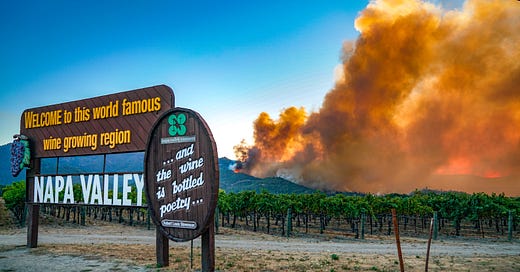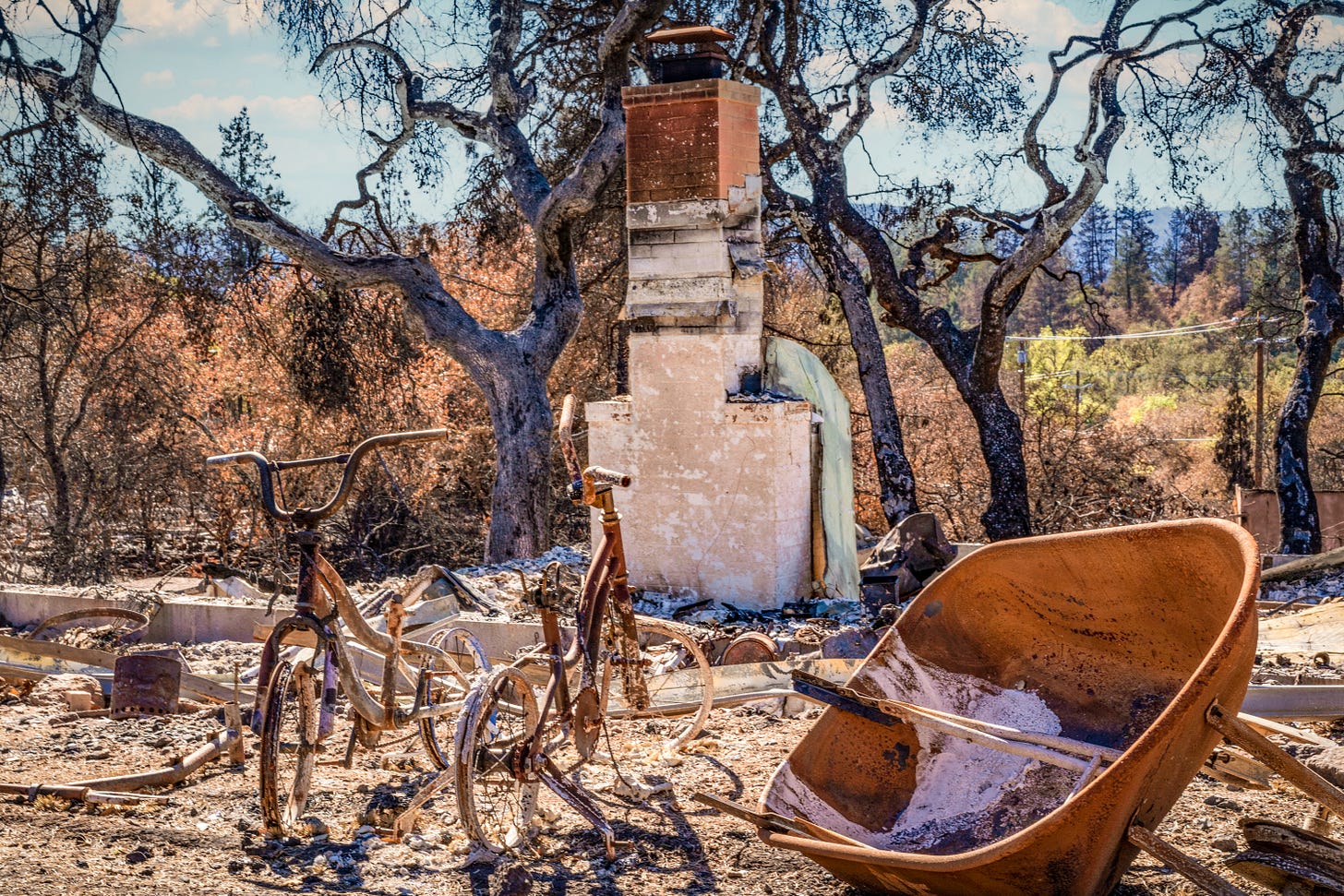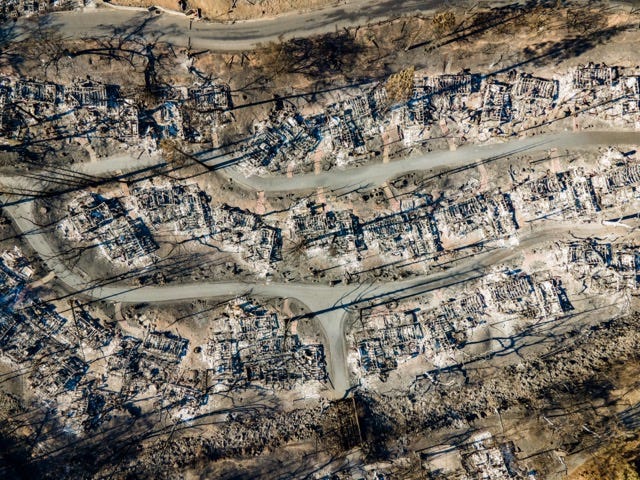The devastating fires in Los Angeles County have left many in need, and thanks to our readers, we’ve been able to help. Because of your support, Napa Valley Features donated $300 in January to the Los Angeles Regional Food Bank. Due to the ongoing need and the generosity of our community, we’re extending this effort through Feb. 15, with 10% of all new paid subscriptions going toward relief. Your support truly makes a difference — thank you.
The Spotlight
Welcome to “Under the Hood,” our exclusive Saturday series for Napa Valley Features paid subscribers. This week we delve into the escalating insurance crisis gripping Napa Valley, where rising premiums, policy cancellations and shifting regulations threaten homeowners, businesses and the region’s economic stability.
Additionally, we’re diving into the latest data from our readers’ polls and providing insights from our economic dashboard, covering local Napa Valley, U.S. and global markets.
In addition, we feature "What We Are Reading," a section with a handpicked list of recent articles that provide a variety of viewpoints on issues important to our community and beyond.
“What We Are Reading” quotes of the day:
"Your private information — everything from bank account routing numbers to Medicare records detailing what prescriptions you take — has been breached by Elon Musk and his cadre of teenage interns. This is wrong." – from Representative Mike Thompson, in "Rep. Thompson, House Democrats Introduce Taxpayer Data Protection Act."
"[State Farm General Insurance Co.] must be able to prospectively demonstrate its ability to generate sufficient capital to support [California’s] risk profile." – from Dan Krause, in "State Farm General Insurance Co. Request for Emergency Interim Rate Approval," from a company press release.
"Part of the [insurance] problem is that many people were coaxed into living in the very high-risk areas they call home precisely by the availability of insurance that was cheaper than it should have been." – from Abrahm Lustgarten, in "That Giant Sucking Sound? It’s Climate Change Devouring Your Home’s Value," The New York Times.
"When you’re used to sleeping for 10 years, and you’re all of a sudden asked to become fierce, and when you’re expected to achieve high objectives, some people can’t." – from Bernard Arnault, in "LVMH CEO Bernard Arnault came up with a new way to describe layoffs: being ‘promoted outwards,’" Fortune.
"We have hundreds of cases of wine in our warehouse already labeled for Canada that aren’t going to be picked up." – from Kenny Likitprakong, in "Trump’s Trade War Has Already Blasted California Wineries," Paolo Bicchieri, San Francisco Chronicle.
“This public health-first approach in the management of alcohol retail sales in Nordic countries is a great demonstration of alcohol policies that work.” – from Dr. Carina Ferreira-Borges, in "WHO/Europe highlights Nordic alcohol monopolies as a comprehensive model for reducing alcohol consumption and harm," WHO/Europe.
Decanting the Data:
Napa Valley’s Growing Insurance Crisis
By Tim Carl
NAPA VALLEY, Calif. — Beneath Napa Valley’s celebrated vineyards, world-class wines and scenic landscapes, a crisis is unfolding. Homeowners, businesses and entire communities are increasingly at risk as the region faces a rapidly shifting insurance market. Already contending with an aging population, shifting tourism trends, climate-driven wildfires and economic uncertainty in the wine industry, Napa Valley now grapples with mounting insurance challenges that threaten its future.
The devastating wildfires that swept through Los Angeles in January 2025 served as a stark reminder of California’s escalating climate risks. With damages estimated at up to $250 billion, the fires underscored the vulnerability of fire-prone regions and prompted insurers to take an even closer look at high-risk areas like Napa Valley. As insurance companies reassess their exposure, residents and businesses face mounting uncertainty — higher costs, stricter underwriting and, in many cases, the potential loss of coverage altogether.
Hugh Davies, a second-generation vintner and president of Schramsberg Vineyards in northern Napa Valley, has seen first-hand how rising insurance costs are reshaping the region.
“We’re paying four or five times what we used to pay,” Davies said. “While premiums continue to skyrocket, deductibles have also increased, while overall coverage has decreased.”
California’s insurance industry has reached a breaking point. Years of catastrophic wildfires, rising costs and regulatory struggles have left major insurers increasingly reluctant to cover high-risk areas. Nowhere is this more apparent than in Napa Valley, where growing wildfire risk and soaring premiums threaten home values and economic stability. As major insurers such as State Farm request emergency rate hikes or withdraw from the market entirely, the future of property ownership in the region hangs in the balance.
A Perfect Storm: Wildfires, Rising Costs and a Changing Insurance Industry
The devastating wildfires that swept through Los Angeles have not only left Southern Californians grappling with immense loss but have also triggered a financial reckoning within the insurance industry. Analysts predict these fires could become the costliest in California history, further destabilizing an already fragile insurance market. State Farm, the state’s largest home insurer, has been at the forefront of this crisis. By Feb. 1, the company had received more than 8,700 claims and paid out over $1 billion to policyholders — an amount expected to rise significantly.
In response, State Farm has requested emergency rate hikes from California regulators: a 22% increase for homeowners, 15% for rental tenants and condominium unit owners, and 38% for rental dwellings. The company justified the request by citing underwriting losses, reporting that for every dollar collected in premiums, it has spent $1.26 on claims and expenses.
"Higher risks should pay more for insurance than lower risks," the company stated in its emergency rate-hike application.
Consumer advocates argue that insurers have long been profitable in California and accuse State Farm of using the crisis to bypass regulatory scrutiny. Doug Heller, director of insurance for the Consumer Federation of America, stated, “They have built up an incredible fortune in order to deal with crisis. If they feel that they are going to need rate hikes in the future, they have a right to go through the process, but to be putting on the emergency siren seems more like trying to bully the state into handing over cash while we’re trying to recover from disaster.”
Regardless, according to a recent First Street Foundation analysis reported in The New York Times, insurance premiums in Napa County are expected to keep climbing, making homeownership increasingly unaffordable. Property values are also projected to remain flat or decline as buyers factor in rising insurance costs — a shift that could fundamentally alter the region’s housing market.
A Region Under Siege: Wildfire Risk and Insurance Challenges
For Napa Valley homeowners, wildfire risk is no longer just a seasonal concern — it is a defining factor in their ability to secure and afford insurance coverage. With major blazes such as the 2017 Tubbs Fire and the 2020 Glass Fire destroying thousands of structures across Napa County, insurers have increasingly categorized the region as a high-risk zone. Since 2017, 62% of Napa County’s land has been affected by wildfire.
Insurance companies rely on their own models to generate risk assessments but often refer to CAL FIRE’s Fire Hazard Severity Zones Maps, which classifies most of Napa County into high-risk categories, as a guide:
52.6% (265,172 acres) is classified as "Very High" risk
15.5% (78,296 acres) is designated as "High" risk
Only 28.4% (143,430 acres) fall outside of these zones, though they may still carry significant risks assessed by local or federal authorities

Such classifications play a significant role in determining insurance eligibility and pricing. CAL FIRE’s FHSZ maps categorize areas into risk zones based on environmental factors such as vegetation, topography and fire history. These maps are primarily intended for planning and regulatory purposes, such as enforcing building codes and defensible space requirements, rather than direct use in insurance decisions. However, much of the data used in these maps overlaps with the data insurers use in their own risk models, which incorporate additional factors like property susceptibility to damage and short-term risks.
Critics argue that while these maps provide valuable guidance for public safety, they may oversimplify risk assessment when applied indirectly to insurance decisions. Insurers' reliance on broad hazard designations can overlook property-specific mitigation measures, such as advanced fire-resistant construction materials or expanded defensible space improvements, leaving proactive homeowners potentially grouped into the same high-risk categories as their less-prepared neighbors.






